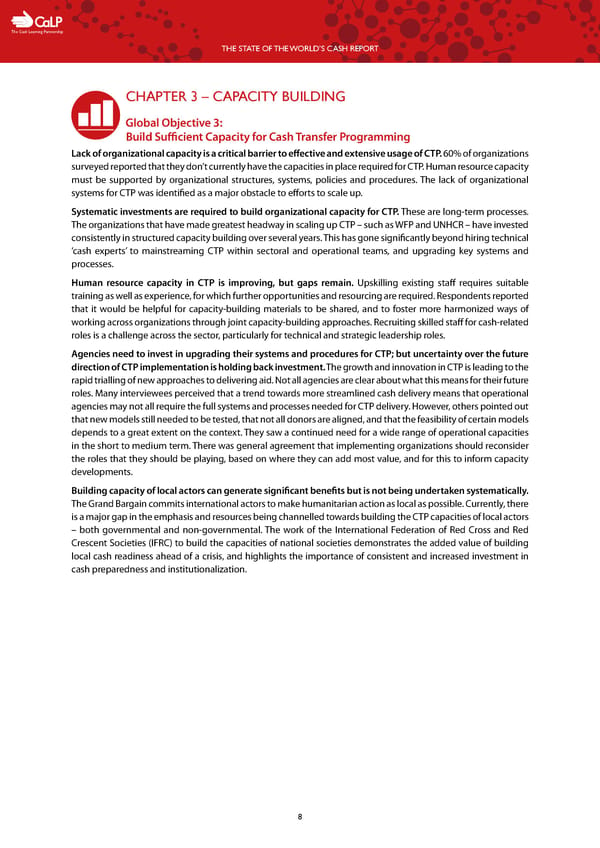C The Cash Learning Partnership THE STATE OF THE WORLD’S CASH REPORT CHAPTER 3 – CAPACITY BUILDING Global Objective 3: Build Sufficient Capacity for Cash Transfer Programming Lack of organizational capacity is a critical barrier to effective and extensive usage of CTP. 60% of organizations surveyed reported that they don’t currently have the capacities in place required for CTP. Human resource capacity must be supported by organizational structures, systems, policies and procedures. The lack of organizational systems for CTP was identified as a major obstacle to efforts to scale up. Systematic investments are required to build organizational capacity for CTP. These are long-term processes. The organizations that have made greatest headway in scaling up CTP – such as WFP and UNHCR – have invested consistently in structured capacity building over several years. This has gone significantly beyond hiring technical ‘cash experts’ to mainstreaming CTP within sectoral and operational teams, and upgrading key systems and processes. Human resource capacity in CTP is improving, but gaps remain. Upskilling existing staff requires suitable training as well as experience, for which further opportunities and resourcing are required. Respondents reported that it would be helpful for capacity-building materials to be shared, and to foster more harmonized ways of working across organizations through joint capacity-building approaches. Recruiting skilled staff for cash-related roles is a challenge across the sector, particularly for technical and strategic leadership roles. Agencies need to invest in upgrading their systems and procedures for CTP; but uncertainty over the future direction of CTP implementation is holding back investment. The growth and innovation in CTP is leading to the rapid trialling of new approaches to delivering aid. Not all agencies are clear about what this means for their future roles. Many interviewees perceived that a trend towards more streamlined cash delivery means that operational agencies may not all require the full systems and processes needed for CTP delivery. However, others pointed out that new models still needed to be tested, that not all donors are aligned, and that the feasibility of certain models depends to a great extent on the context. They saw a continued need for a wide range of operational capacities in the short to medium term. There was general agreement that implementing organizations should reconsider the roles that they should be playing, based on where they can add most value, and for this to inform capacity developments. Building capacity of local actors can generate significant benefits but is not being undertaken systematically. The Grand Bargain commits international actors to make humanitarian action as local as possible. Currently, there is a major gap in the emphasis and resources being channelled towards building the CTP capacities of local actors – both governmental and non-governmental. The work of the International Federation of Red Cross and Red Crescent Societies (IFRC) to build the capacities of national societies demonstrates the added value of building local cash readiness ahead of a crisis, and highlights the importance of consistent and increased investment in cash preparedness and institutionalization. 8
 The State of the World's Cash | Full Report Page 9 Page 11
The State of the World's Cash | Full Report Page 9 Page 11